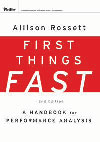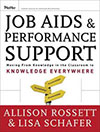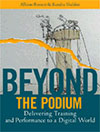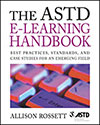That technology sinner is me.
I sinned this morning. I awoke at 5:30 AM to address an elearning conference in Europe via Adobe Connect. By 5:50 AM, with colorful earrings in my ears, and virtually suitable clothing on top, I was ready for the webinar.
This isn’t about technology failure. Connect worked like a charm. Or I think it did.
And therein lies the problem. I presented for 45 minutes, with PowerPoint, to the assembled group. I used lively examples, provocative questions, and a few self-effacing personal stories. I prompted for reflection and urged application, and I pointed to relevant, accessible resources. I smiled and gesticulated through my web cam.
I tried. I worked at it. Doesn’t it sound like I did a good job?
Your guess is as good as mine. I do not know how my webinar went. Not a hint. It was impossible to tell. I delivered my keynote into an abyss.
I posed questions and after suitable wait time, I answered them myself. I texted, but received no participant responses. Throughout the session, I received no feedback. I heard nothing. I saw nothing. They might have been tossing beach balls around the auditorium. Was it an auditorium? I solicited questions at the conclusion and was informed by text chat that it was time for them to move on.
I have no clue if my audience liked it, paid attention during it, or took notes about it.
It’s important to recognize that I am not setting a high bar here. I am not talking about transfer to the workplace or the value attendees would assign to my messages. While those are proper concerns, early this morning I found myself worrying about things that are lower in Maslow’s hierarchy. Were they facing the screen during my session? Could they hear me?
When I shared this experience with a friend, she blamed it on Europeans’ Friday afternoon attitudes. They were ready for the weekend, not another presentation. Perhaps they were quietly hostile, she suggested. I doubt it, but acknowledge it could be true. The way the technology was set up for the webinar, I couldn’t tell if they were cheering, booing or sleeping.
It’s possible that they were cheering
 If it went well, and it might have, attribute it to the fact that I’ve done many webinars before. I prepared carefully. Prior to the event, I asked questions about the audience, and then thought hard about what would be useful for them. I made educated guesses. I constructed materials to provide a way for them to follow along readily, tracking progress throughout. I structured carefully because they are not native English speakers. I scaffolded and I summarized. I put time into testing the technology.
If it went well, and it might have, attribute it to the fact that I’ve done many webinars before. I prepared carefully. Prior to the event, I asked questions about the audience, and then thought hard about what would be useful for them. I made educated guesses. I constructed materials to provide a way for them to follow along readily, tracking progress throughout. I structured carefully because they are not native English speakers. I scaffolded and I summarized. I put time into testing the technology.
The sin
What then was my sin? Sometimes you have to push back, say NAY, demand some things, like interactivity, as a core component in the delivery of the program. Noisy in the webinar, I was silent about standards before and during it. Just because I could do something with technology did not mean I should.
As someone who has blogged about quality in webinars, it is fair to read this story and wonder what was I thinking? I know better. How could I participate in this? (Don’t be thinking money. I did it for free.) I sat in San Diego and declaimed. I sprayed my content across the USA and Atlantic Ocean and over to Europe, to a country I have never visited. I went on a toot for 45 minutes and nobody riffed back. I was a caricature of the one-way presenter. Now, seven hours after we concluded the webinar, I’ve heard not a word from a participant or organizer. No tweets either. It’s as if I tossed my webinar into the Grand Canyon.
You are probably curious about the topic for my webinar. Engagement. Engagement was my topic. More irony, I think.






Loved reading this Allison 🙂 There truly are boundaries for the use of Adobe Connect and any other tool or solution dependent on the content – it’s a shame we’ve all become so unreachable that we have to always (mostly) depend on technology to connect us. At the same time, it’s amazing what you can accomplish with it – much more efficient (in many cases) than flying around the world, spending money on flights, wasting time with travel and poluting Mother Earth – I have been on Adobe Connect / similar 100% of my time since 2007 and we’ve built four larger tools, processes and certification programs with software build, test and deploy – all done virtually (we’ve never met). Hence, it does work but perhaps not for the topic of Engagement on a Friday afternoon in Europe 🙂 Wishing you a lovely weekend! Cheers, Jason
I used to do presentations for an employer over a similar tool. I lived on the West Coast, but would host them for companies all over the world. And in some cultures the norm was that if you asked questions that indicated disrespect to the speaker.
So I’d get up in the middle of the night, do my little dog and pony show to absolutely NO RESPONSE AT ALL, and go back to sleep. It was like a bad dream.
And a few days later I’d get an email that was very complimentary, saying how much people had enjoyed it and how useful it had been. Kind of like a parallel universe. Don’t miss that period of my life at all.
It sounds like this session was significantly different from the Webex session our teams had with you a couple of weeks ago. Our largely North American team was charged and ready to go! Questions and opinions flashed on and off the Webex chat window with startling rapidity. But our teams are intensely interested in change at the moment…they feel the earth shifting under their feet and are motivated to learn and act…
Engagement and motivation…I believe we separate them at our peril,
Thanks Allison,
Joe
Joe,
Makes me happy to hear the work with your group in no way resembled this webinar. Thanks for that. Perked me right up.
Hi Joe
The key in your feedback is with ‘engagement and motivation” The two should not be seperated in either distance learning nor online presentations. I take a page out of Internet marketing. Why would someone opt in to your webinar? What will they get from it? How can you gauge throughout the session that you actually address what they crave for? I am sure that it is something that you are very good at Allison and focussed on in your delivery. Your concern is a reminder to us to stay tuned into the reasons (motivation) our audiences will adhere to when they engage.
This reminds me of the Halloween party my college room mate threw one year, and no one came. Not saying the webinar attendees weren’t there, but they certainly weren’t participants. This is a lesson for us all, Allison. Thanks for sharing!
Hmmmm, maybe they were having an animated discussion about your earrings! Seriously, this is a keen reminder to all of us to engage the audience early, just to be sure someone is out there, whether through polling, chat, or VOIP. Even a simple “hey what’s the setup look like in your room” or the old “where are you on this map” thing. Thanks for sharing.
Well, Id say there is a more than even chance you were talking into thin air!! Fri afternoon in Europe – they’ve already shot through and are drinking wine at home or the tapas bar!! You’re provocative enough that if anyone was there you would have got at least ONE response from someone.
I deliver a presentation on the web – usually with Adobe Connect – at least once a week. I have even focused my dissertation on instructor/presenter behaviors to increase presenter immediacy. Despite my experience and knowledge I find myself constantly challenged with finding ways to increase engagement. Especially when you don’t have a prior relationship with the audience and you are delivering a one-off presentation you need to first connect with the audience and then win their attention. We all know that our number one sin when joining web conferences is multitasking, or more truthfully doing other things and barely paying attention to the web presenter. That’s why we have come up with so many techniques to engage our audiences, like constantly changing slides, bombarding them with poles and questions, etc. etc. I think that despite how engaging we are as presenter most people will still multitask – it is sooo tempting! That’s why now WebEx came up with the feature of monitoring attendee activity on the screen so the instructor/presenter can “police” user activity. I do not look forward to that!
Face to face is an appropriate delivery method… especially when it involves a trip to Europe =D
Thanks for sharing this, Allison. As someone who preps others who train on webinars, what you describe is often the reality. I’m constantly looking for new ways to get participants to engage in meaningful ways – to keep them focused but also to help the speaker feel connected with them. I still think it’s possible but it’s a challenge. Webinars are so much more difficult than in-person training – the energy is just not the same. That said, you are such a dynamic and engaging speaker, I can’t imagine that your energy didn’t reach through to the other side!
I fight this all the time. It’s not the ‘webinar’s’ fault if event organizers insist on herding groups into a room and have them only watch the screen as if it’s just a one-way live TV broadcast. Tools like text chat and whiteboarding are very easy to use with most virtual classroom products, but not if people can’t put their hands on a keyboard or otherwise interact with the speaker. There are other ways, too: At a recent London event I was in the audience for a very engaging keynote in which Elliot Masie came in via video from the U.S. on a big screen, but encouraged us to chat among ourselves and feed him questions by phone. It was very effective — and facilitated by the onsite event organizer.
In my world this happens more from control (“you will sit here and I will watch you watch it”) than from any logistical need. I try to find out ahead of time what organizers have in mind and don’t usually agree to these setups anymore, but it still happens. But yes, the irony of being asked to speak on “engagement”, when no provisions will be made to allow any, is rich. My own favorite: A recent webinar on “Social Learning” in which the phones were muted and public text chat was disabled. Um….